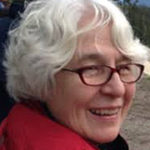ed. Robyn Wrigley-Carr
London: SPCK, 2018
Reflections: Ann Loades
Robyn Wrigley-Carr wrote her doctoral thesis in the Divinity School, St Andrews University, having discovered there the primary location of books and other materials relating to Friedrich von Hügel, focussing on his work as a ‘spiritual director’. It was almost inevitable that she would also develop a focus on the work of Evelyn Underhill, and some familiarity with the work of Evelyn’s friend, Lucy Menzies. The latter became Evelyn Underhill’s collaborator as writer, researcher and co-‘retreat director’ at Pleshey in the Chelmsford Diocese from 1924 onwards (p.8). It is all too easy to overlook the importance of what they achieved together given the long- standing discomfort in Christian institutions about women as authoritative teachers and guides, notwithstanding the unambiguous evidence provided by the publication of Evelyn’s major work on Mysticism in 1911, never out of print in its various editions and revisions. Offering Evelyn’s gifts to the Church of England as a ‘retreat director’ was one very effective way of familiarising those who attended with the traditions of both the Christian and to some extent, non-Christian traditions of prayer, whether or not they were acquainted with the major publication of 1911 and the series of shorter books she published subsequently.
In giving retreats twice a year at Pleshey and in a group of other diocesan houses, Evelyn necessarily had to focus on gathering together her resources both in the prayers she offered to those gathered for retreats, and for the six retreat addresses she published subsequently (listed on p.9). Thanks to Dr Wrigley-Carr, her prayers can now be re-read in tandem with the fortuitous re-discovery of not one but two of Evelyn’s hand-written Prayer Books. These Dr Wrigley-Carr has most skilfully combined into one publication, beautifully presented in a volume of a hand-held size, and a jacket which replicates the binding of one of the re-discovered books, the binding very probably the personal handiwork of Evelyn herself, given her skill in this craft.
Dr Wrigley-Carr rightly focuses on the importance of von Hügel in steering Evelyn into overt identification as a member of the Church of England, the church of her baptism, her confirmation (a somewhat miserable episode which had become the responsibility of the boarding school in which she had spent some of her adolescent years) and her marriage. Those familiar with her life-story will recall that the crisis over ‘Modernism’ at the time of her marriage clarified for her the importance of attending to new sources of knowledge whilst attending to and reinterpreting the tradition she came publicly to inhabit. With that tradition in its various forms she was already well acquainted. Written before she turned to the writing of Mysticism and the exploration of her re-commitment to the Church of England over a period of time, Evelyn’s three novels –often overlooked- reveal her extensive knowledge of and empathy for liturgical worship and its resources, some of which in any case she had experienced not only in visits to Roman Catholic churches but to a range of ‘Orthodox’ traditions both in London, and, crucially, in travelling in mainland Europe over many years.
Dr Wrigley-Carr has most judiciously marshalled Evelyn’s two prayer books into one coherent whole, but has also provided ‘Author biographies and liturgical sources’ (pp.131-132) in the order in which their authors appear in her edition of the prayers. Especially helpful are also some notes on the ‘Church Liturgies’ on which Evelyn drew – one of the most exemplary and ecumenical members of the Church of England in her day, the fruits of which were to appear in her last major work on Worship (1936). This edition of her prayers is not, however, organised along the pattern of the liturgical year, given its origins in resources for conducting retreats. Its users could well enjoy finding their own ways of appropriating its contents, and find it refreshing and indeed sometimes surprising. Evelyn’s voice brings other voices alive, and in joining Evelyn’s voice with theirs in a clear and constructive way, Dr Wrigley-Carr most commendably brings her into our own times and places.

Ann Loades CBE is Professor Emerita of Divinity, University of Durham and Honorary Professor in the School of Divinity, St Andrews, Scotland.
Reflections: Carol Poston
While doing dissertation research on Friederich von Hugel at Pleshey Retreat House, Robin Wrigley-Carr came upon two small bound volumes of Evelyn Underhill’s prayers and has edited and published them into a single, attractive small volume. The editor has gathered the two original books into one, not duplicating from the second book entries that had already appeared in the first. Since she uses Underhill’s original page numbers to distinguish each set of prayers in the first volume, she is unable to do so after that but rather continues pagination with her own consecutive numbering in order to avoid starting over. That fact (and the additional fact that there are regular page numbers as well) might make it confusing to readers who would like the repeated prayers noted in some way, thus indicating Underhill’s favorites.
In addition, the title could be misconstrued to mean that Underhill used it only privately, but in fact these prayers were shared at certain intervals during the three days of prayer with her retreatants at Pleshey. A less ambiguous title might have been The Prayer Books of Evelyn Underhill, since to Anglicans the Prayer Book usually refers to the Book of Common Prayer.
Wrigley-Carr has provided us with a graceful introduction focusing upon the contributions of von Hugel to Underhill’s prayer life, a real addition in my mind. She also lists of the authors of some of the prayers and has calculated that the source that appears most frequently is The Imitation of Christ. Authors from the third to the twentieth century are represented, the latest being Underhill’s friend Margaret Cropper. All the other prayers (and a majority of the original second volume) are presumably prayers written by Underhill herself. This volume bespeaks the wide reading and learning that underlay her preparation for those retreats.
Underhill’s revisions are noted, and they awaken this reader’s interest. The editor cites several times when Underhill’s pencil hesitates between “God” and “Christ,” marking out “God” for “Christ,” perhaps a sign of some theological hesitancy. She also notes where Underhill herself seems to have revised her sources by words struck out or replaced —whether because the original was not accurate or because she has settled on a better word, we do not know.
In Underhill’s prayers we occasionally see poetic cadences borrowed from the psalms and occasionally a striking image from her poetic style–for example “the hills of God, the snowfields of the Spirit” in number 103. Prayer number 80, for example, is so poetically arranged that one is tempted to think that that it came from another source.
Editorial decisions can always be debated, but this editor would have retained Underhill’s careful language and quite clear spellings. Replacing “Do Thou bless” simply with “bless” does violence to Underhill’s beautiful cadences. Her orthography corrections seem sometimes inconsistent– retaining “judgement” but correcting “neighbour” to “neighbor” seems inconsistent. Finally, even 21st century readers should have no trouble “thee” and “thou” in literary work. Changing “O Thou” to “O God” and freely substituting “fruits meet for repentance” to “fruits in keeping with repentance” seem hardly an improvement, since that original language is still part of our hymns and of Rite I in the BCP, as in “it is meet and right so to do.”
These reactions pale in the face of the fact that we see here Underhill’s poetic style and great learning put to the task of her own devotions and those she served in the retreats.

Carol Poston is professor of English emerita, St. Xavier University